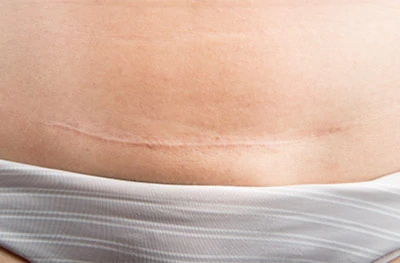Are Vaginal Births Possible after a Cesarean (VBAC)
One persistent myth about Cesarean delivery is that after you have one, you can never deliver vaginally again. Although there are some risks to keep in mind, this is simply not true. In general, women who plan to have children again after a previous Cesarean section(C-section) have two options for their next birth:
- Another C-section
- Or vaginal birth after cesarean delivery, also known as VBAC.
VBAC isn’t right for everyone, though. Certain factors, such as a high-risk uterine scar, can lower your likelihood of VBAC and make the option inappropriate.
Most women who deliver a VBAC give birth to healthy babies and suffer no complications.

What are the risks of Vaginal Birth after Cesarean (VBAC)?
While VBAC is associated with fewer complications than an elective repeat C-section, a failed trial of labor after a C-section is associated with more complications, including, rarely, a uterine rupture. During a uterine rupture, the uterus tears open. An emergency C-section is needed to prevent complications, such as heavy bleeding for the mother and life-threatening injury to the baby.
Sometimes, the uterus might need to be removed (hysterectomy) to stop the bleeding, putting your future pregnancies at risk. If your uterus is removed, you won’t be able to get pregnant again.
Benefits of Vaginal Birth after Cesarean (VBAC)
Cesarean delivery is a major surgical procedure. Many women prefer to deliver vaginally for a variety of reasons. A successful VBAC has many benefits, such as:
- Less invasive than surgery.
- Shorter hospital stays and quicker recoveries.
- Less pain during recovery.
- Decreased risk of infection, scarring, and tissue damage.
- Ability to stay awake and actively participate in the birth of your baby.
- Decreased risk of complications associated with multiple C-sections (i.e., injury to the bladder or bowel, placenta abnormalities, and hysterectomy).
What is Trial of Labor after Cesarean Delivery (TOLAC)?
TOLAC stands for a trial of labor after Cesarean delivery. It refers to the mother’s attempt to deliver vaginally following a previous C-section. A TOLAC is a plan to deliver vaginally; at least until something occurs that changes the plan. About 40% of women who attempt a TOLAC will undergo another C-section to complete the delivery.
TOLAC Risks

The greatest risk of a TOLAC is the possibility of a scar rupturing from your prior C-section. The surgical scar runs either vertically or horizontally across your uterus, and if it ruptures, this could pose life-threatening consequences to you and your baby.
The rupture of this scar is rare; however, some women are at higher risk for rupture than others. The shape and location of the scar affect your particular risk.
- Low risk: Transverse – The uterine incision scar runs left-to-right across the uterus. If you’ve only had one or two transverse C-sections, you’re a good candidate to attempt a TOLAC with relatively low risk.
- High risk: Vertical incision – The scar runs from the top of the uterus to near the bottom. It is recommended that you do not attempt a TOLAC.
When deciding whether or not to try a TOLAC, you should ask yourself a few questions.
- Do you want to have more children after this birth? The greater number of C-sections you have, the riskier it becomes to attempt a TOLAC.
- Has your uterus ever ruptured? This significantly increases your chances of a second rupture.
- Is your birthing facility prepared to handle any emergency that may arise from a failed TOLAC?
- Are there any other factors that may complicate your vaginal delivery (placental abnormalities, abnormally-shaped uterus, macrosomia, malpresentation, etc)?
Discuss your concerns with your OB/GYN.
What meds may be used during a Vaginal Birth after C-Section (VBAC)?
Artificially inducing labor. As you approach delivery, your cervix will begin to dilate to allow the baby through. In some cases, your OB/GYN may administer oxytocin to dilate the cervix earlier or strengthen contractions – this is called inducing labor. Inducing labor is not recommended for all women attempting TOLAC if it could increase the risk of uterine rupture.
Pain management. As with any vaginal delivery, women undergoing VBAC should be able to manage the pain with narcotic drugs, local anesthesia, and/or an epidural, which will numb the body from the waist down. There is no evidence to suggest that anesthesia will increase the risk of uterine rupture during TOLAC.
Changes to your Delivery Plan
Encountering complications during your TOLAC can make it unsafe to give birth vaginally. This may occur if something is wrong with you or the baby, or if you need to have your labor induced. Your maternity health care provider will do everything they can to respect your wishes for a vaginal birth, but sometimes an emergency C-section will be unavoidable.
On the other hand, some pregnant women choose to have a repeat cesarean but then decide to change their plan if they go into early labor and the baby appears healthy.
Whatever you decide, be sure to talk with your doctor about the possible changes that could occur during labor so that you can carefully weigh the risks and benefits in advance. Include your birthing partner in your plans so that you can have his or her full support throughout your delivery.
Why Choose Dr. Aliabadi
As one of the nation’s leading OB/GYNs, Dr. Thaïs Aliabadi offers the very best in women’s health and well-being. With her warm, professional team, Dr. Aliabadi supports women from puberty to pregnancy, childbirth, menopause, and beyond. She fosters a special one-on-one relationship between patient and doctor.
Highly trained and honored by the medical community, Dr. Thais Aliabadi is certified by the American Board of Obstetrics and Gynecology and a Diplomat of the American College of Obstetrics and Gynecology. She implements the most advanced, state-of-the-art technology and treatment options.
Dr. Aliabadi specializes in up-to-date, minimally invasive surgical techniques for fibroids, polyps, and endometriosis, promising her patients shorter recovery times, reduced pain, and the least interruption to their daily lives.
We also invite you to establish care with Dr. Aliabadi. Please make an appointment online or call us at (844) 863-6700.
















